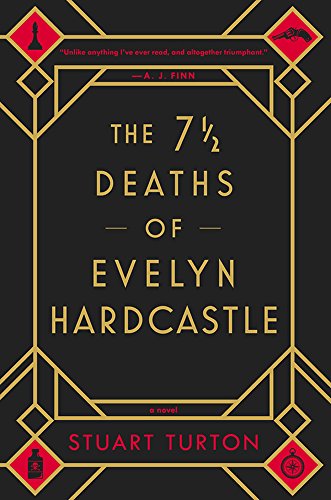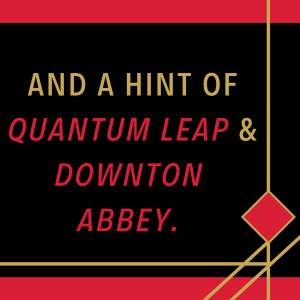![]() The 7½ Deaths of Evelyn Hardcastle by Stuart Turton
The 7½ Deaths of Evelyn Hardcastle by Stuart Turton
 Debut author Stuart Turton’s The 7½ Deaths of Evelyn Hardcastle (2018), originally published earlier this year in Great Britain as The 7 Deaths of Evelyn Hardcastle, is an intricately plotted murder mystery, set in an isolated early 20th century English mansion, with a highly imaginative speculative element that is only gradually revealed, as our main character tries to figure out who he really is, and how to solve the mystery of Evelyn Hardcastle’s pending death … or has her death already occurred?
Debut author Stuart Turton’s The 7½ Deaths of Evelyn Hardcastle (2018), originally published earlier this year in Great Britain as The 7 Deaths of Evelyn Hardcastle, is an intricately plotted murder mystery, set in an isolated early 20th century English mansion, with a highly imaginative speculative element that is only gradually revealed, as our main character tries to figure out who he really is, and how to solve the mystery of Evelyn Hardcastle’s pending death … or has her death already occurred?
The plot and setting are worthy of Agatha Christie: Lord and Lady Hardcastle have invited a number of guests to their British country mansion, Blackheath House, for a weekend party to celebrate the return of their daughter, Evelyn, from Paris. (The notable guests and household staff are conveniently listed in a copy of the party invitation at the beginning of the book.) One of the guests, Dr. Sebastian Bell, suddenly comes to himself while running through the forest surrounding Blackheath. The name “Anna” was on his lips, but he has no idea who Anna is or who he himself is. His memory is completely blank. Bell is horrified to see a man chasing a woman through the forest, and then a scream and a pistol shot.
Eventually Bell, with a little mysterious help, makes his way back to the mansion, where he tries to convince the other guests to search for the woman he is certain was murdered in the forest. But nobody at Blackheath knows (or in any case admits to knowing) a woman named Anna, and they’re dubious about Bell’s improbably story, particularly in light of his amnesia. Bell meets several of the other guests, including Evelyn Hardcastle, a blonde woman in her late twenties who quickly strikes up a friendship with him (“I loathe getting to know people, so whenever I meet somebody I like, I just assume a friendship immediately. It saves a great deal of time in the long run.”) In the late evening Bell sees something that frightens him so much he faints. He wakes up in another person’s body ― the butler, Mr. Collins ― in the morning of the same day that he just lived through as Sebastian Bell. His day as Collins is even more hellish than it was the first time around. And then he wakes up again, early in the morning of that same day, in another person’s body. Is there a way out of this nightmare?

I went into The 7½ Deaths of Evelyn Hardcastle without knowing anything about its plot; I had conveniently forgotten the blurb by the time I began reading the book. Normally I hate not having context in a novel, and being confused about what the book I’m reading is generally about. But in this case going in blind was highly appropriate, because our main character (who does find out his real name eventually) initially has no idea who he actually is or what is going on around him. The light sheds very gradually, but it all comes together in the end with an awesome set of twists and turns that Dame Christie herself certainly would have admired. Characters often aren’t who they seem, and events that seemed to signify one thing frequently turn out to have an entirely different meaning.
The plot of The 7½ Deaths of Evelyn Hardcastle is so layered, with a tremendously tight timeline and so many interwoven elements and characters, that I can’t help but picture Turton writing this novel in a room filled with vast numbers of Post-it notes and crisscrossing strings tying everything together. (Turton has, in fact, stated that he used a massive spreadsheet, a notepad for each character, and a map of the setting ― as well as the aforementioned Post-it notes ― in the process of writing this book.) The speculative element is fascinating, if slightly far-fetched, but undeniably creative. When the main character realizes that the personalities of his host bodies are leaking through, affecting his thoughts and reactions, it deepens the plot.
On top of this, Turton adds insightful writing that’s a pleasure to read. I highlighted some sixty passages in the book; some of them were to help me keep track of the plot and characters, but others were simply for the beauty of Turton’s writing.
She’s trying to anchor me with words … but I’m impervious to reason, consumed by my hatred for the man I was. His flaws I could accept, perhaps even overcome, but this is a betrayal. He made his mistakes and fled, leaving me holding the tatters of his scorched life.

Turton also adds symbolism to The 7½ Deaths of Evelyn Hardcastle, including the decaying mansion, Blackheath, which echoes the failings and degeneracies of the upper class characters who are the guests at this dubious house party. A chess piece appears and reappears. A person in the costume of a plague doctor shares information with our main character about his situation and his mission.
This compelling murder mystery, wrapped in a soft science fiction enigma, is a truly impressive debut novel. Its combination of classic British mystery, Groundhog Day and Quantum Leap blew my mind! I enthusiastically recommend it, and I seriously can’t wait to see what Stuart Turton comes up with next.
~Tadiana Jones
![]() I don’t have a lot to add to Tadiana’s review of The 7 ½ Deaths of Evelyn Hardcastle. Mostly I’m just nodding my head in agreement, adding my voice briefly to her strong recommendation, and hoping that the update on this page will send more people to this thoroughly enjoyable and stimulating novel.
I don’t have a lot to add to Tadiana’s review of The 7 ½ Deaths of Evelyn Hardcastle. Mostly I’m just nodding my head in agreement, adding my voice briefly to her strong recommendation, and hoping that the update on this page will send more people to this thoroughly enjoyable and stimulating novel.
I loved the premise of a character waking up in a series of bodies, reliving the same murderous day — a kind of roll up of the films Groundhog Day and Gosford Park and Agatha Christie’s country manor mysteries such as Crooked House and Peril at End House. I actually enjoyed the premise twice, once at its mysterious introduction and again when it was explained. The plotting was meticulous (I’m a huge fan of books that requires the reader to pay close attention) and like Tadiana, I can’t imagine the process that went into the ensuring it all added up just right. Twists and turns are plentiful enough that if you can guess one or two, you’re unlikely to get them all, or even most (I patted myself proudly on the shoulder for guessing a twist and then was quickly humbled by a series of events I never saw coming).
 As one example of a series of creative touches, Turton goes beyond the tension of an impending murder, which is where most would stop, and layers atop that a greater sense of urgency thanks to the manner in which the main character is losing more of himself with each transference into a host, making it a race not just to save the victim but himself as well. And whereas it would have been easy to blur the various hosts into the same sort of “decayed aristocracy” character, each is imbued with a sense of individuality.
As one example of a series of creative touches, Turton goes beyond the tension of an impending murder, which is where most would stop, and layers atop that a greater sense of urgency thanks to the manner in which the main character is losing more of himself with each transference into a host, making it a race not just to save the victim but himself as well. And whereas it would have been easy to blur the various hosts into the same sort of “decayed aristocracy” character, each is imbued with a sense of individuality.
It also would have been easy to have relied on the compelling plot to carry the reader through — the simple desire on the part of the reader to “read to find out who killed Evelyn.” And I admit that’s what I expected, and so I was pleasantly surprised by how much I enjoyed the writing itself, which was sharp throughout and nicely attuned to character and situation. It can be dryly funny, as when the main character is forced to bear the monotony of a dull conversation: “Herrington’s spent the evening tossing around tedious stories without bothering to indulge in the courtesy of exaggeration.” It can be allusive: “I’ve read my Dante, Philip. Not all hells are created equal.” And at all times when turned to descriptive mode it does a wonderful job of vividly evoking the sense of physical (and, as Tadiana notes, moral) decay of the setting, with its “peeling green door, swollen with age and cracks,” the “crumbling brickwork,” the “long gravel driveway … covered with weeds,” the “grandfather clock … mechanism rusting, second turned to dust on its pendulum,” the rat poison piled in corners. Everywhere one turns, things are “threadbare,” “faded,” “splintered.” A pen is leaking, a gramophone is spinning but transmitting no sound. It’s a fantastically cumulative sense of rot and deterioration.
Compelling, twisty, sneaky plot. A character it’s impossible not to root for. A growing sense of dread and urgency. A winning stylistic voice. And some emotional punches I’m not detailing so as to avoid spoilers. What’s not to like? Highly recommended.
~Bill Capossere




Well, I know what I’m asking Santa for this year! :D This sounds amazing!
You should definitely read this one, Jana!
This sounds wonderful.
Sold!
Cool! I’ve accomplished my purpose.
I did something with this book I’ve never done before. The moment I finished it I flipped back to the beginning and read it again. That’s because it was so riveting as I first read it that I had to fly through it to find out what happened — and it was so great I wanted to read it again to find out what the heck happened! Both readings earned top stars.
This book is definitely on my “reread sometime soonish” list! Unfortunately my TBR pile is out of control right now, so this one has to wait a while.
I choose to believe the ultimate explanation is a lie because it’s a great book until the every weak ending that simply doesn’t stand up. Well worth reading regardless.
I can’t say I was fully 100% on board with the ending, but I was willing to roll with it for the sake of the story.
I got it for my birthday along with The ten Thousand Doors of January, by the same author. =)